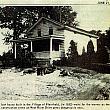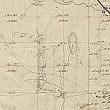Plainfield to Move Old House
by Mary Jean Malkewitz
An appeal from local historian Homer Burch, Heritage Hill Association member Barbara Roelofs, and Grand Rapids Museum Curator W.D. Frankforter resulted in action by the Plainfield Township Board to save an historic landmark in this area. The Board voted in favor of a request by the three citizens to save the Hunting House on West River Road, which is threatened by a road improvement project. The house must be removed by July 1 to make way for the County road equipment which will be widening and surfacing West River Road beginning on July 1.
Preliminary plans call for the dwelling to be moved across West Rive Drive and onto DNR property which was recently purchased by the Michigan Conservation Department as a fishing site. The temporary location for the building will be near Indian Drive. Cost for the move will be under $2000.
At present, the Board has no immediate plans for use of the historical home although suggestions have been put forward it could be used for meeting place for civic groups, historical societies or possibly a library. The home is one of the last buildings of the Village of Plainfield or Austerlitz and was, according to Mr. Burch, the prettiest house in the village. It features Greek revival architecture, is 20 feet wide by 30 feet long and for some years served as the post office. “It is a shame to see the house destroyed,” said Burch. “It is a lovely little home and should be preserved for posterity.”
History of Village
Prior to 1836, the land on West Rive Drive at the end of the Northland Bridge over the Grand River was Indian Territory, and after the treaty of 1836 the Village of Plainfield was born. The first settler was a farmer, George Miller, who farmed the land where the Blythefield Country Club now stands. His first home was a log cabin. The superintendent of the golf course now occupies the old Miller farmstead.
The next settler at Plainfield Village was Andrew DeWitt Stout who was a ferryman on the Grand River. A blacksmith, he established a hotel in 1837. A short time after that, the post office was established, but the name of the village had to be changed as it was the same as one in Livingston County. However, even though the settlement was called Austerlitz after the battle site in the time of Napoleon, the local people still called the town Plainfield. The village received its name from the first settler who named it after Plainfield, New Hampshire.
Within 10 years after its founding, Plainfield had 800 residents, 4 hotels, 6 saloons and several businesses. It was a stopping off place for the flat boats which were bringing settlers up and down the Grand River. In 1844 a mail route from Grand Rapids to Cannon Center passed through Plainfield, and on the 4th of July, 1848, the village had a big excursion celebration on the river, competing with the village of Grand Rapids for importance. In 1850, there was a move to make Plainfield Village the county seat.
Plainfield Village was also important because it was on the old Indian trail which led to the Saginaw Valley, which became the stagecoach route to the east. The trail started at the Campau trading post on Monroe, came out Coldbrook to Plainfield Avenue to the foot of Rockhill. Skirting the hill, the trail made its way to the head of Grand Island in the Grand River where the water was shallow and the river could be forded easily or crossed by foot. From there the trail crossed the Rogue River and then went on the bluffs of the present Blythefield Country Club. The Plainfield-Sheridan trail, as it was called, continued east to the Saginaw Valley with take off points to the townships of Cannon, Courtland and Oakfield. Settlers coming by flat boat would use Plainfield as an exit to the trail. Plainfield Village also served as a way station for the overland route from Detroit to Grand Rapids. The stagecoach went from Detroit to Pontiac, to DeWitt and followed the Looking Glass River to Portland, Lyons and Ionia, thence through Cannon Township to Plainfield Village and down Plainfield Avenue to Grand Rapids.
Plainfield Village lost out to Grand Rapids and Belmont (first named Whitney) when the railroad was put through Belmont. The village had depended on the Grand River and stagecoach for its survival.
House built in 1852
The Hunting house itself was built by Doctor William Hyser in 1852 for his new bride, Jeanette M. Saunders, who bore him 4 children. Dr. Hyser had moved to Plainfield after his graduation from Buffalo University in 1850. He was born in Herkimer County, New York, 1826, and there is no date recorded for his death. He enlisted as a Captain in the 6th Michigan Cavalry in 1863, received a disability discharge and re-enlisted in 1864, serving in 2 campaigns with General Grant on the Potomac. As a resident of the Village of Plainfield, the doctor held the office of Township Clerk, Justice of the Peace, School Inspector and Supervisor and was a member of the Masonic Order. The post office of Austerlitz was also in his home.
The last reference to the post office was May 30, 1902 after which mail was sent to Belmont.
Rockford News, June 21, 1973

 facebook
facebook




